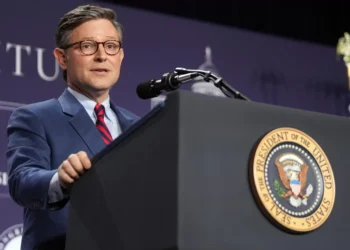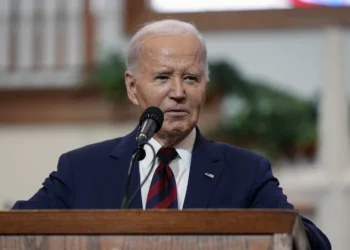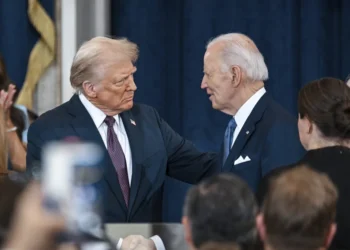In March 1983, Ronald Reagan proposed the Strategic Defense Initiative (SDI), a missile defense system that was part of his restoration of our military power and capabilities after the disastrous Jimmy Carter years. It was one piece of Reagan’s strategy to end the Cold War by forcing the Soviet Union into political insolvency. And he succeeded.
While SDI was derisively panned as “Star Wars,” Reagan’s forward-looking advocacy for research into space- and land-based antiballistic missile technologies resulted in the development of many classified weapons systems. I referenced in a column on Unidentified Aerial Phenomena (UAP) four years ago the possibility of “DARPA-type R&D programs” developing “energy weapons with an electronic signature that can be altered,” and “weapons which leverage energy or perhaps even gravitational forces for locomotion — using gravitic propulsion systems.”
Those UAP systems are not to be confused with the hysterical UFO hysterics regarding drones over New Jersey last December.
A year before President Reagan announced SDI, I learned about it from LTG Daniel “Danny” Graham (USA, Ret.), who had established the High Frontier think tank in 1981. Before High Frontier, Danny was chairman of the American Space Frontier Committee and the Coalition for the Strategic Defense Initiative, and in 1978 became co-chairman of the Coalition for Peace through Strength, all associated with defense against nuclear intercontinental ballistic missiles (ICBMs).
Danny was one of the most affable military leaders I have met — “disarming,” in fact, but not to be underestimated.
High Frontier focused on space-based kinetic-energy weapons and directed-energy technologies such as lasers and particle beams, which were a good fit for Reagan’s “peace through strength” doctrine.
In President Reagan’s 1991 remarks on the 10th anniversary of the founding of High Frontier, he said to LTG Graham: “As you know, Dan, you and I were talking about missile defense before you set up High Frontier in September of ‘81. … You and a small group of dedicated, determined people helped us move the SDI concept over all the roadblocks put up by people of less vision and belief in American capacity. God bless you!” Danny died four years later, but he is to be fully credited with the SDI concept.
A year later, the Strategic Defense Initiative Organization was renamed the Missile Defense Agency and continues as such under the Department of Defense today. Its focus is now more on traditional ground-based missile interceptor systems such as the Aegis BMD, THAAD, and Patriot PAC-3 (MIM-104 Patriot) system — the latter most people have seen in media reports about intercepting enemy missiles during Operation Iraqi Freedom and is now a significant component of Israel’s Iron Dome missile defense network.
Fast-forward to 2019, when Donald Trump re-designated Air Force Space Command (AFSPC) as a new service branch, the United States Space Force. Elements of SDI’s space-based ballistic defense systems immediately reemerged under USSF’s Space Development Agency — indicative of what Trump had in mind.
While I originally did not fully support Trump’s Space Force carveout, in a conversation earlier this month with GEN Chance Saltzman, Chief of Space Operations, Trump’s objective six years ago is now clear.
By way of an executive order on 27 January of this year, President Trump directed Space Force to establish a multilayer defense capability to counter “the threat of ballistic, hypersonic, and cruise missiles” to the U.S. (CONUS), noting, “The threat of attack by ballistic, hypersonic, and cruise missiles, and other advanced aerial attacks, remains the most catastrophic threat facing the United States.”
Trump mentioned in his March address to the nation, “I am asking Congress to fund a state-of-the-art golden dome missile defense shield to protect our homeland.”
This week, Trump officially announced the “Golden Dome” defense system, which he and SecDef Pete Hegseth declared will be a next-generation “game changer” protecting the American homeland. He estimated an initial cost of approximately $175 billion and said it will be “fully operational before the end of my term.”
According to Trump: “In the campaign, I promised the American people that I would build a cutting-edge missile defense shield to protect our homeland from the threat of foreign missile attack. And that’s what we’re doing today. [Golden Dome] will be capable of intercepting missiles even if they are launched from the other side of the world and even if they are launched from space.”
Trump already allocated $25 billion for Golden Dome development in the defense allocation of his federal budget bill, which is now under consideration by Congress. The Congressional Budget Office estimates the cost will be $542 billion over 20 years.
As defense spending goes, I fully support this round. It is a national defense reset.
Trump said Space Force GEN Michael Guetlein, second in command under GEN Saltzman, will be in charge of the project: “No one is more qualified for this job.”
According to Hegseth: “Ultimately, the Golden Dome for America is a game changer. It’s a generational investment in the security of America and Americans.” Addressing Trump, he added, “President Reagan 40 years ago cast the vision for it. The technology wasn’t there. Now it is, and you’re following through to say we will protect the homeland from cruise missiles, ballistic missiles, hypersonic missiles, drones, whether they’re conventional or nuclear.”
The most perilous ICBM threat to CONUS is from Red China, the ChiComs. The Defense Intelligence Agency just released an assessment that China has about 400 ICBMs, while Russia has about 350 and dictator Kim Jong-un’s North Korea has fewer than 10, but he is a Chinese surrogate. And there is the emerging threat from Iran and its rogue terrorist surrogates.
GEN Saltzman recently told Congress that China’s space-based targeting capabilities have “grown most impressively” and called China’s technological advances “mind-boggling.” GEN Guetlein had previously revealed that Space Force has tracked China’s offensive capabilities, including “five different objects in space maneuvering in and out and around each other in synchronicity and in control.” Additionally, he noted: “That’s what we call dogfighting in space. They are practicing tactics, techniques, and procedures to conduct on-orbit operations from one satellite to another.”
Predictably, Chinese Foreign Minister Mao Ning protested: “The project will heighten the risk of turning space into a war zone and creating a space arms race, and shake the international security and arms control system. We urge the U.S. to give up developing and deploying [the] global anti-missile system.”
This is precisely the organized chaos “shake” that Trump dumps on China with a smile.
As for the next round of “Star Wars” naysayers, Tom Karako, director of the Missile Defense Project at the Center for Strategic and International Studies, says, “This is going to be well-rooted in the systems engineering and the understanding of the threat and in the overall architecture plans that have been in the works for a long time.” He adds that it is “a belated realignment of U.S. missile defense policy” to counter threats from China and Russia.
There have been enormous advances over the last 30 years, and with AI, those have accelerated exponentially. Consider the proven technological advances demonstrated by Elon Musk’s SpaceX in just the last two years.
Thank you, President Reagan and LTG Danny Graham, for your persistent vision and vigilance!
Semper Vigilans Fortis Paratus et Fidelis
Pro Deo et Libertate — 1776

















